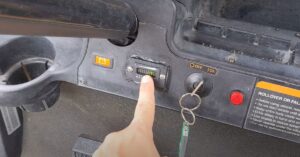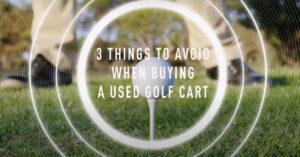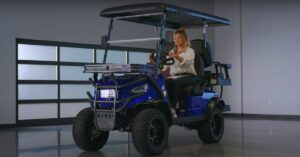What To Look For When Buying A Used Golf Cart?
When purchasing a used golf cart, several important factors must be considered before deciding. Investing in a pre-owned cart can be a cost-effective option for golf enthusiasts, but ensuring you get a reliable and suitable vehicle for your needs is crucial.
When buying a used golf cart, it’s essential to consider factors such as its condition, battery life, maintenance history, and intended use. These aspects are crucial in determining the cart’s reliability and longevity, ensuring an informed decision.
In this blog post, we will explore the key aspects to consider when buying a used golf cart, guiding you toward a smart and informed purchase.
Evaluating The Condition of used golf cart: Signs Of Wear And Tear
When purchasing a used golf cart, it’s crucial to carefully assess its condition to ensure you’re getting a reliable vehicle. Here are some signs of wear and tear to look out for:
Exterior Appearance
- Check for any dents, scratches, or rust on the cart’s body. These can indicate previous damage or poor maintenance.
- Inspect the tires for wear patterns and ensure they have sufficient tread depth. Uneven wear may suggest alignment or suspension issues.
Battery Condition
- If the cart is electric, examine the batteries for signs of corrosion or leakage. Such issues can affect the cart’s performance and lifespan.
- Ask about the age of the batteries and their maintenance history. Older or poorly maintained batteries may require replacement soon.
Mechanical Components
- Test the brakes to ensure they engage smoothly and bring the cart to a stop without any unusual noises or vibrations.
- Check the suspension by gently rocking the cart from side to side. Excessive movement or squeaking sounds could indicate worn-out components.
- Inspect the steering system for any play or stiffness. A well-functioning cart should have responsive and precise steering.
Electrical System
- Test the headlights, turn signals, and brake lights to ensure they are functioning correctly. Faulty lights can be a safety hazard.
- Check the cart’s charging system and make sure it charges properly. Verify that the charger is included and in good working condition.
Interior Condition
- Examine the seats, flooring, and overall cleanliness of the cart’s interior. Excessive wear, stains, or damage may indicate neglect or heavy use.
Assessing the Battery of used golf cart: Buying a Used Golf Cart
It’s crucial to assess the lifespan and performance of the battery when purchasing a pre-owned one. A reliable battery ensures smooth operation and longevity for your golf cart. Here’s what you need to know:
Battery Age
- Determine the age of the battery by checking the manufacturing date or asking the seller.
- Batteries typically have a lifespan of 4-6 years, so consider the remaining life when buying used.
- Older batteries may experience diminished performance and require replacement sooner.
Battery Maintenance
- Inquire about the maintenance history of the battery, including regular charging and watering.
- Well-maintained batteries tend to last longer and offer better performance.
- Look for signs of corrosion or leaks, which can indicate neglect or damage to the battery.
Battery Voltage
- Check the voltage rating of the battery, which determines its power output.
- Golf carts commonly use 36V or 48V systems, so ensure the battery matches the cart’s requirements.
- Using an underpowered or overpowered battery can affect the cart’s performance and potentially cause damage.
Battery Performance Testing
- Request a performance test to evaluate the battery’s capacity and overall health.
- Load testing measures how well the battery holds a charge under a simulated workload.
- A reputable dealer or technician can perform these tests to provide valuable insights.
Battery Warranty
- Check if the used battery comes with any remaining warranty coverage.
- A warranty can provide peace of mind and financial protection in case of battery failure.
- Understand the terms and conditions of the warranty, including any limitations or exclusions.
Checking The Motor of used golf cart: Power And Efficiency
When purchasing a used golf cart, inspecting the motor for power and efficiency is crucial. This will ensure a reliable and enjoyable ride. Here are key points to consider:
Assessing Motor Power
- Motor power directly influences the cart’s performance and ability to handle various terrains.
- Examine the cart’s specifications to determine the motor’s horsepower rating.
- Ensure the motor’s power is adequate for your intended use, whether it’s for a golf course or off-road adventures.
- Take note of any modifications made to the motor, as they can impact its performance and reliability.
- Test-drive the cart to assess the motor’s power firsthand and evaluate its responsiveness and acceleration.
Evaluating Energy Efficiency
- Look for electric golf carts that offer energy-efficient motors to reduce operating costs.
- Check the battery’s condition and age, as worn-out batteries may compromise the cart’s efficiency.
- Inquire about the cart’s range per charge and charging time to gauge its suitability for your needs.
- Consider carts with regenerative braking systems, which recover energy during braking and enhance overall efficiency.
- Research the manufacturer’s reputation for producing energy-efficient golf carts.
Examining The Frame And Body of used golf cart: Structural Integrity
When examining the frame and body of a used golf cart for structural integrity, several key aspects must be considered. Here are some important points to keep in mind:
Visual Inspection
Start by thoroughly examining the entire frame and body of the golf cart. Look for any signs of visible damage, such as dents, cracks, or rust.
Pay close attention to areas where the frame and body components join together, as these are common weak points.
Structural Alignment
Check if the frame and body of the golf cart appear to be properly aligned. Misalignments could indicate previous damage or improper repairs. Look for any signs of uneven gaps or panels that don’t line up correctly.
Rust and Corrosion
Inspect the frame and body for any signs of rust or corrosion. Rust can weaken the structural integrity of the cart over time.
Focus on areas where moisture can accumulate, such as underneath the cart or around wheel wells.
Welds and Joints
Examine the welds and joints on the frame and body. Look for signs of poor welding or excessive weld repairs, as these could be indicators of previous damage.
Make sure the welds are solid and free from cracks or separation.
Test for Stability
While inspecting the golf cart, gently shake it from side to side to check for any excessive movement or instability. The frame should be rigid and provide a stable base for the cart.
Previous Repairs
Inquire about any previous repairs or accidents that the golf cart may have undergone. This information can give you insights into the condition of the frame and body.
Inspecting The Tires, Suspension, And Brakes Steering of used golf cart: Smooth And Safety Ride Quality
When buying a used golf cart, it is important to inspect various components to ensure a smooth and safe ride quality. Here are the key areas to focus on:
Tires
Check the condition of the tires, including the tread depth and any signs of wear or damage. Uneven wear patterns could indicate alignment issues or suspension problems.
Ensure that the tires are properly inflated for optimal performance.
Suspension
Inspect the suspension system for any signs of damage or excessive wear. Look for worn-out bushings, leaking shock absorbers, or bent components. A well-maintained suspension system contributes to a smoother ride.
Brakes
Test the brakes to ensure they are in good working condition. Check for responsiveness and any unusual noises or vibrations when braking.
Inspect the brake pads or shoes for wear and make sure the brake lines are free from leaks or damage.
Steering
Evaluate the steering system by turning the wheels left and right. The steering should feel smooth and responsive without any excessive play or resistance.
Pay attention to any strange noises or vibrations while steering, as they could indicate issues with the steering mechanism.
Ride Quality
Take the golf cart for a test drive to assess its overall ride quality. Pay attention to how it handles bumps or uneven terrain.
A well-maintained suspension, properly inflated tires, and smooth steering will contribute to a comfortable and safe ride.
Verifying The Charging System of used golf cart: Functionality And Compatibility
When buying a used golf cart, it’s important to verify the functionality and compatibility of the charging system to ensure it meets your requirements.
Here are some steps you can follow to assess the charging system:
Inspect the Charging Equipment
Examine the charging equipment that comes with the golf cart. Check for any visible damage or signs of wear.
Ensure that all the necessary components, such as the charger, cables, and connectors, are present and in good condition.
Charging Voltage and Amperage
Determine the voltage and amperage requirements of the golf cart’s battery system.
Check if the charger’s voltage output matches the golf cart’s battery voltage. Also, verify that the charger’s amperage rating is suitable for the battery system.
The charger should not exceed the recommended amperage to avoid damaging the batteries.
Charging Plug Compatibility
Confirm that the charging plug on the golf cart matches the connector type on the charger.
Common connector types include Anderson, SB, or proprietary plugs. Make sure they are compatible to ensure a secure and proper connection during charging.
Test the Charging Process
If permitted by the seller, perform a charging test. Connect the charger to the golf cart and observe if it starts charging properly.
Monitor the charging process to ensure it proceeds smoothly without any unusual noises, sparks, or overheating.
The charger should complete the charging cycle within a reasonable time frame.
Charging System Accessories
Check if the golf cart comes with additional charging system accessories, such as a battery monitoring system or a timer.
These accessories can provide useful information about the battery’s state of charge and enhance the charging process.
Essential Paperwork: Titles, Maintenance Records, And Warranties
It is important to ensure that you have all the essential paperwork in order.
This documentation will help you verify important information about the vehicle, such as its ownership, maintenance history, and any warranties still in effect.
Here are the key documents you should obtain:
Title
The title is the most crucial document as it establishes legal ownership of the golf cart. Ensure that the seller provides you with a clear and valid title that is properly signed and dated.
It’s important to check if the seller’s name matches the name on the title to avoid any potential issues.
Warranty Information
If the golf cart is still under warranty, ask the seller for the warranty documentation.
This will help you determine if any repairs or replacements are covered by the manufacturer or an extended warranty plan.
Be sure to check the warranty’s duration and any specific terms or conditions.
Bill of Sale
The bill of sale is a legal document that outlines the terms and conditions of the purchase.
It includes details such as the buyer’s and seller’s names, purchase price, date of sale, and any additional terms or agreements.
Make sure both parties sign and retain a copy of the bill of sale.
Vehicle Identification Number (VIN) Check
Before finalizing the purchase, verify the golf cart’s VIN by comparing it with the one on the title and other documentation.
This ensures that the vehicle’s identification number matches all paperwork and helps prevent potential fraud or issues.
Frequently Asked Questions
If you’re considering buying a used golf cart, it’s important to know what to look for to ensure you make a wise purchase. To help you in your search, here is a list of quick and clear FAQs about what to consider when buying a used golf cart.
How Can I Assess the Condition of a Used Golf Cart?
Inspect the cart thoroughly for any signs of damage or wear, such as rust, dents, or worn-out tires. Check the battery’s age and condition, and test all the cart’s electrical components.
Take it for a test drive to assess its performance and listen for any unusual noises.
How Do I Evaluate the Cart’s Overall Performance?
Test the cart’s acceleration, braking, and steering responsiveness. Ascertain if it can handle inclines or rough terrain, especially if you plan to use it on a hilly golf course.
Assess the cart’s suspension system and ensure it provides a smooth and comfortable ride.
What Documents Should I Request Before Making a Purchase?
Ask for the cart’s maintenance records and history to verify its servicing and repair details.
Check if it has a valid title and registration. Additionally, obtain the cart’s serial number to ensure it’s not stolen, and consider getting a warranty, if available, to protect your investment.
Conclusion
When purchasing a pre-owned golf cart, keep these essential factors in mind: examine its condition thoroughly, ensure the battery is in good shape, inspect its maintenance history, and consider the price.
You can make a wise and satisfying purchase decision by prioritizing these aspects.





